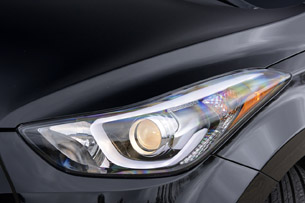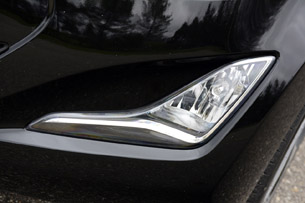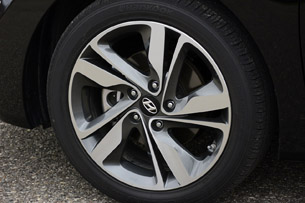2014 Hyundai Elantra Review
-
Engine1.8L I4
-
Power145 HP / 130 LB-Ft
-
Transmission6-Speed Automatic
-
DrivetrainFront-Wheel Drive
-
Curb Weight2,943 LBS
-
Seating2+3
-
Cargo14.8 CU-FT
-
MPG27 City / 37 HWY
-
Base Price$17,200
-
As Tested Price$25,335
-
The reality of growing up and living in Detroit is an interesting one. You're essentially born with minute traces of gasoline in your veins and everyone you know is associated with the auto industry in some way. That's not an exaggeration. They might be the child of a line worker at the local auto plant, or they may hold down a job at a restaurant frequented by employees at a big supplier, but no matter what, everyone is part of the auto-industry ecosystem.
Because of this, the stories you may have heard about Detroiters and their distaste for foreign cars is, frustratingly, true. Simply put, Toyota and Honda are blatantly disliked by most, while BMW and Mercedes-Benz are merely tolerated. For a car reviewer who prides himself on making egalitarian recommendations, it's a frustrating environment to live in, particularly when friends and family ask that inevitable question – which is followed by an equally inevitable qualifier – "What should my next car be?" and "One more thing – it can't be foreign." It's this attitude that's perhaps the reason no one I know even considered buying a Hyundai Elantra.
Despite the fact that the compact sedan is built in Montgomery, AL and that Hyundai maintains a shiny, new, sprawling tech facility less than 45 minutes outside of downtown Detroit, the Elantra's status as a "foreign" car immediately precludes it from most Motown buyers' shopping lists. This is to their detriment, as I discovered during a week of testing the refreshed-for-2014 Hyundai Elantra.



Hyundai unveiled its mid-cycle update of the Elantra back in November at the 2013 Los Angeles Auto Show. The model-year changeover renewed the Elantra's fascia, with a slightly different grille design, but the dominant change up front for higher-end models is a set of new LED-trimmed headlights, along with revised foglights. In back, LED taillights have been added. While these sound like relatively minor changes, their impact on the Elantra's presence cannot be overstated. The new headlights and taillights add a touch of class, giving it a more upscale appearance, particularly at night. The halogen headlights sport a subtle, but stylish LED ribbon, one that's considerably different than the borderline obnoxious accents found on other vehicles. In fact, the overall effect is similar to what Audi has accomplished with its A4 and A5, opting for an unbroken stream of light in favor of individual diodes, as on earlier models.New headlights and taillights add a touch of class, giving a more upscale appearance, particularly at night.
This philosophy of subtle but impactful exterior changes hasn't really been carried over into the cabin. This is more or less the same well-thought-out, nicely trimmed interior as it was way back in 2011. Plastic remains the dominant material inside, although the Elantra's solid fit and finish and a lack of sharp edges means it isn't a detriment. The leather-wrapped steering wheel on my Limited tester is a nice touch as compact cars go, with hide that feels like quality material. The same can be said of the leather that line the seats – obviously this isn't the kind of stuff you'd find in a Mercedes-Benz Designo interior or from Bentley's Mulliner works, but in the $25,000 space, it's quite nice.



The benefit of making minimal interior changes is that the Elantra remains a very easy cabin to live with. The tilt-telescopic steering and eight-way power driver's seat proved perfectly adequate in finding a comfortable seating position for my six-foot, one-inch frame. Those seats aren't hugely supportive, though, feeling more flat than cosseting. The upside is easy ingress and egress, while backseat passengers have a reasonable amount of legroom, with the Elantra's 33.1 inches falling just short of the Ford Focus and its 33.2 inches. Really, though, if rear-seat space is your priority, you'd be much better served by a Chevrolet Cruze (35.4 inches) or a Nissan Sentra (37.4 inches). Visibility, meanwhile, remains excellent all around.This is more or less the same well-thought-out, nicely trimmed interior as it was way back in 2011.
In terms of actual cabin space, the Elantra is on par with rivals, despite the lack of rear legroom. Its 95.6 cubic feet of passenger volume is actually 0.6 cubic feet more than the Cruze and just 0.3 cubic feet short of the Sentra. It's a similar story in regards to cargo volume, with the Elantra down less than a half a cubic foot on its rivals, at 14.8. That cargo area is pretty easy to expand, too, with a standard 60/40 split rear seat. As is the fashion, the model's rear bumper is high and the trunk opening isn't exactly gaping. Really, though, if you're buying an Elantra for utility, you'd be best off ignoring the sedan and going straight for the long-roof GT.
While Hyundai has opted to fit a new, 2.0-liter four-cylinder to a number of trims in the Elantra family, my tester made do with the old 1.8-liter Nu engine. With just 145 horsepower and 130 pound-feet of torque, I'd be lying if I said I wasn't wishing for the extra 28 horsepower and 24 pound-feet of torque of the 2.0-liter four found in the four-door Elantra Sport.

While the 2,943-pound Elantra certainly could do with more power, there's enough on offer with the naturally aspirated 1.8-liter for commuting. The Elantra can still outgun the heavier, non-turbo Chevrolet Cruze, after all. Peak power arrives at 6,500 rpm, just 250 rpm south of redline, while peak torque arrives at a lofty 4,750 rpm. There's enough usable power in the lower and middle parts of the rev range to keep the Hyundai from feeling oppressively slow, but you'll still have to dig pretty deeply into the skinny pedal to make use of all the ponies and torques.You'll have to dig pretty deeply into the skinny pedal to make use of all the ponies and torques.
This might be an issue in a car with a buzzier exhaust note, like a Dodge Dart, but it's not a big deal in the Elantra. The Hyundai packs a comparatively refined four-cylinder tone that doesn't intrude too strongly into the cabin, and it's paired with an accelerator that's not overly abrupt, offering up well-judged modulation.
Of course, you aren't going to want to be too forceful with the throttle if you're hoping to match the 37-mile-per-gallon EPA highway rating listed on the Elantra's window sticker. I had little issue approaching that figure during a week of heavy freeway use, recording 34 to 35 mpg throughout my week. The 31-mpg combined rating seems easily achievable, and indeed, higher figures in mixed driving should be possible, provided you take advantage of the Eco mode button, which tamps throttle response and alters the transmission's shift schedule in an effort to return greener numbers. The Elantra's highway rating and its 27-mpg figure in the city match nicely with the competitive Focus and Cruze, although the domestics do offer fuel-sipping options – Focus SFE and Cruze Eco – that elevate them beyond the Hyundai.




Speaking of transmissions, opting for the Limited trim locks you into the six-speed automatic. As has become the case in the world of modern gearboxes, there's nothing particularly wrong with this unit. Dig into the throttle and it serves up a lower gear without much hunting about, and upshifts are dispatched smoothly and without drama or histrionics. And despite the fact that not a single customer will use it for sporting purposes, the Elantra features a manual shift mode on the gear lever, something that at least may be useful on long descents.One of the more significant pieces of tech added to the Elantra 2014 is its Driver Selectable Steering Mode.
One of the more significant pieces of tech added to the Elantra Sedan for 2014 is its Driver Selectable Steering Mode, a bit of technology that first appeared on the 2013 Elantra GT. With three different profiles available via wheel-mounted button, drivers can easily tweak steering effort to their whim. As is the usual case, Comfort offers the lightest degree of effort while Sport is the heaviest. In Normal and Comfort mode, the steering is a bit too light on center for my tastes, although weight does build progressively through the turns. Still, the steering's lackluster on-center feel hurts the Elantra's sense of stability at freeway speeds and on bumpy roads. The problems with these modes in general, though, is that regardless of which setting is selected, there is an utter and complete lack of feedback – a fairly predictable reality for a car in this class fitted with electronic power-assisted steering.


Taking steering out of the equation, though, and the Elantra's overall poise is quite good. MacPherson struts with coil springs in front and a torsion axle with coils in the back underpin the car. The result is a fairly composed ride, one that responds well to bumps and imperfections. Unlike a certain matte-gray Autoblog long-termer from Hyundai with a similar suspension setup, the Elantra doesn't sidestep when encountering imperfections mid-corner. The ride has certainly been helped by Hyundai's decision to pass on larger wheels in favor of comfort-minded 17-inch stock, wrapped in the meaty sidewalls of 215/45 Hankook Optimo rubber.Ride quality has been helped by Hyundai's decision to pass on larger wheels in favor of comfort-minded 17-inch stock.
Despite offering up a softer ride and a thicker sidewall, the ride isn't particularly floaty. Roll comes on smoothly and doesn't cause the chassis to feel out of sorts when pushed through a turn, while squat and dive are on par with the class. As is the case with the steering, feedback through the chassis is quite limited. There are certainly more compelling driver's vehicles in this segment of the market, especially one from a certain Zoom-Zoom brand. Not surprisingly, this soft ride is also pretty quiet. There's not a lot of tire roar or wind noise to contend with, and the engine is quiet at idle.
Sitting behind those standard 17-inch wheels are a fairly basic set of brakes comprised of 11-inch, vented front rotors and 10.3-inch solid rears. The hardware may not be remarkable, but stopping power is totally adequate, and the brake pedal feels solid and predictable. It's also easy to modulate, allowing subtle adjustments to braking effort in the middle of deceleration.

The Elantra's $17,200 starting price is competitive with the $16,810 Focus while undercutting the $18,345 Cruze. The Limited model tested here, meanwhile, kicks off at $21,650, which is quite a bit cheaper than the $23,075 Focus Titanium and $23,085 Cruze LTZ. The Elantra's standard goodies match up well, too, with leather seats, Hyundai's BlueLink telematics system, 17-inch wheels, the cool LED-accented headlights and LED taillights and a rear-view camera all coming as standard. The sole option is a $2,750 Technology Package, which adds a seven-inch touchscreen navigation system, a so-so 360-watt stereo, dual-zone climate control, push-button start and a sunroof. Including an $810 destination charge and a $125 set of carpeted floormats, the as-tested price for this Elantra is $25,335.The Elantra's $17,200 starting price is competitive with the $16,810 Focus while undercutting the $18,345 Cruze.
That's certainly comparable with an equally equipped Focus Titanium, which rings up at $25,590. The Hyundai maintains its advantage over the Cruze, though, which checks out at $26,420. Really, though, considering that both the Cruze and Focus offer slightly more power and comparable economy numbers, the pricing argument is a wash.
Considering its price and accomplishments, the Elantra is a car that should, logically, be cross-shopped against the domestic competitors. It's an equal in virtually every way, it's arguably more attractive than many in the segment, it's economical, it's priced competitively, and it has a screaming warranty.
Now, if my fellow Detroiters could only get over that badge...
UPDATE: A previous version of this story stated that the Elantra's Driver Selectable Steering Mode defaulted back to Normal upon startup. This was incorrect. The story has been edited to reflect this.
Autoblog accepts vehicle loans from auto manufacturers with a tank of gas and sometimes insurance for the purpose of evaluation and editorial content. Like most of the auto news industry, we also sometimes accept travel, lodging and event access for vehicle drive and news coverage opportunities. Our opinions and criticism remain our own – we do not accept sponsored editorial.



